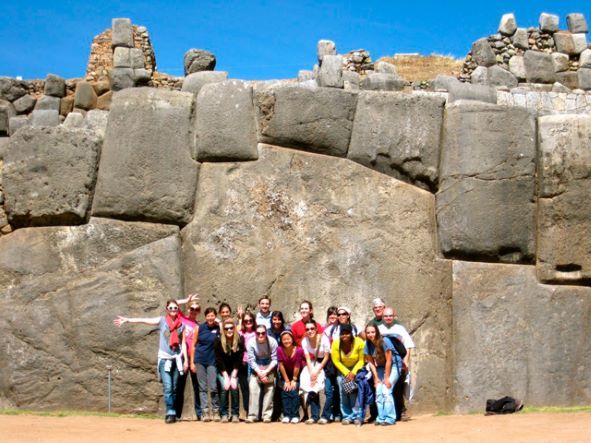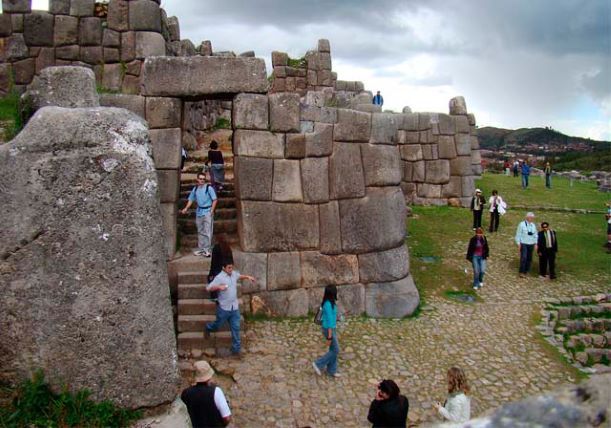Sacsayhuaman in Peru is an archaeological group located north of the main square of the city of Cusco. To get to Sacsayhuaman in Cusco you can take a City Tour from any travel agency. You can also get there on foot, by taxi or using your own vehicle.
To get to Sacsayhuaman in Peru by foot from the main square, you can do it by going up Sweden street, turn onto Huaynapata and continue along Resbalosa, turn right after the church of San Cristóbal and follow the road. Here, you will join the ancient Inca route to Sacsayhuaman. The climb is steep and takes approximately 30 minutes from the Plaza de Armas.
Where is the fortress of Sacsayhuaman located?

sacsayhuaman 
sacsayhuaman
The archaeological fortress of Sacsayhuaman is located 2 kilometers north of the Plaza de Armas in Cusco. It is located at 3,700 meters above sea level (m.s.n.m.).
It extends over an area of more than 3,000 hectares, on a hill surrounded by mountains. The place has beautiful landscapes with abundant flora and fauna (the llamas and hawks stand out).
What does Sacsayhuaman mean?
The term Sacsayhuaman means in Quechua “place where the falcon is satiated.” The name is surely due to the presence of these birds. It is presumed that it was a fortress, although it is also believed that it could have been a ceremonial center.
Due to its military-looking structure, the Spanish, upon their arrival in the 16th century, would have named it a ‘fortress’. When the Spanish attack there was repelled during the Vilcabamba Inca rebellion, the place served as an Inca fortress.
How to get to Sacsayhuaman in Cusco?
The fortress of Sacsayhuaman is only 10 minutes from the Plaza de Armas of Cusco (by car) or 45 minutes walking. Another option is to take a ‘City Tour’, which includes transportation to this archaeological site. The entrance is with the Tourist Ticket of Cusco.
The best option to get to Sacsayhuaman is a tour in Cusco, like the 3 Days Cusco Tour or the 5 Days Cusco Tour.
Attractions in Sacsayhuaman Peru
The Sacsayhuamán ruins itself has important architectural and natural parts, which have their own meanings and stories, such as:
The Torreones
They are called Muyuccmarca, Paucarmarca, Sallaqmarca and are located in the upper part of the bastions (zigzag walls). In Inca times they were towers arranged in a straight line on the top of the hill, in this place there was abundant water, even today we can still see part of the aqueducts.
Muyuccmarca comes from Quechua: “Muyuq” means: round, “Marca”: population. Its rediscovered bases show its circular shape, which has three concentric circumferences, all of them inserted in a square with unequal sides.
Paucarmarca, on the south side of the Sayaqmarca, is covered with earth, possibly it could be quadrangular, etymologically “Pauca” means festive, beautiful, happy, garden and “Marca” population. It is believed that it was dedicated to the stars.
Sallaqmarca is on the side of Muyuccmarca and etymologically comes from “Sallaq” rough, stony and “Marca” population. Currently only the foundations of the Torreones remain, the buildings were destroyed in the early days of the colony, their foundations covered with earth; they were later located and recovered by Dr. Luis E. Valcárcel.
Group of Enclosures
This group of enclosures is located on the top of the hill, to the south and a short distance from the towers. They are beautiful rooms supported by the hill, overlooking the squares of the Inca city. The rooms themselves have the characteristic of being long and narrow, communicated by a series of trapezoidal doors. Its walls are made of irregular polyhedra, with steep faces and well-polished edges.
The Bastions
This is the name given to the three platforms that form a set of recesses and projections formed by walls made of blocks of limestone rock, impressive irregular polyhedra assembled with the utmost perfection. The first Spaniards attributed its construction to demons, even today it is said that aliens are the ones who made this work. These bastions are considered a wonder worldwide.
The doors
Located in the central and middle part of the bastions, with trapezoidal shapes, they served as entrance to the tower area. The three mentioned gates are: T’iopunku, Ajawanapunku, Wiracochapunku.
Rolling or Suchuna
Geologically it is a natural formation of diorite, of volcanic origin, which emerged modulating on its surface warps and striations like slides.
The Throne of the Inca or K’usilluc Jink’ian
Translated these words correspond to “where the monkey stands.” It is a succession of seats, carved in diorite rock with a deep aesthetic sense, it is on the eastern portion of the hill.
Chincanas
There are two of them in the Sacsayhuamán ruins, the smallest together with Warmi K’acchana is short in length and has become a distraction for visitors. The big one is further north, under a large limestone rock, this passage is flooded and it is not possible to enter it. According to geologist Dr. Carlos Kalafatovich, these tunnels, called chincanas, correspond to undermining by the action of groundwater that circulated through the caves.










